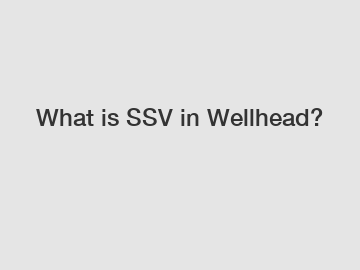What is SSV in Wellhead?
What is SSV in Wellhead?
The wellhead is a vital component of an oil or gas well. It serves as the interface between the subsurface reservoir and the surface production facilities. It is responsible for controlling the flow of fluids from the well, ensuring safety, and facilitating various well operations. To achieve these functions, the wellhead is equipped with several valves, including the Surface Safety Valve (SSV). In this article, we will discuss what the SSV is and its significance in the wellhead system.
The Surface Safety Valve (SSV) is a critical valve installed on the wellhead. Its primary purpose is to prevent the uncontrolled release of hydrocarbons from the well during production or other operations. The SSV is designed to automatically close when certain predetermined conditions are met, such as high pressure or flow rate. By doing so, it helps to maintain the integrity of the well system and prevent any potential hazards.

Importance of SSV:
The SSV plays a crucial role in ensuring the safety and reliability of wellheads. It acts as a fail-safe mechanism that shuts off the flow of hydrocarbons in the event of an emergency or abnormal condition. This is particularly significant during well testing, well intervention, and workover activities when the well pressure or flow rate may exceed the normal operating range. The SSV provides a means to isolate the wellhead from the production facilities, thus protecting both personnel and equipment.
Functioning of SSV:
The SSV operates based on certain set parameters that trigger its closure. It is typically connected to a control system that continuously monitors the pressure, flow rate, or any other relevant parameters. When these parameters reach or cross the predefined limits, the control system sends a signal to the SSV, prompting it to close. The closing action is usually rapid, taking place within seconds to prevent any potential hazardous incidents.
Types of SSV:
There are various types of SSVs available in the market, each designed to cater to specific applications and operating conditions. The most common types include hydraulic, pneumatic, and electrically operated SSVs. Hydraulic SSVs are preferred for high-pressure applications as they offer more precise control and fail-safe features. Pneumatic SSVs are suitable for moderate pressure conditions, while electrically operated SSVs are often used for low-pressure applications or in remote locations where access to a hydraulic or pneumatic power source may be limited.
Maintenance and Testing:
To ensure the optimal performance of SSVs, regular maintenance and testing are essential. Routine inspections, including checking for any leakages, corrosion, or mechanical wear, are conducted to identify any potential issues with the valve. Additionally, periodic testing is performed to verify the functional integrity of the SSV. This includes testing the closure response time, verifying the activation of the control system, and ensuring the proper sealing of the valve.
Conclusion:
In conclusion, the Surface Safety Valve (SSV) is a critical component of the wellhead system. It serves as a vital safeguard, preventing uncontrolled release of hydrocarbons and ensuring the safety of personnel and equipment. Regular maintenance and testing of the SSV are necessary to ensure its optimal functioning. To learn more about SSVs or any other wellhead-related queries, please don't hesitate to contact us.
[Contact Us].
Want more information on api 16c manifold supplier, api kill manifold, ssv valve? Feel free to contact us.


